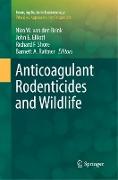Anticoagulant Rodenticides and Wildlife
BücherAngebote / Angebote:
Commensal rodents consume and spoil crops and food supplies, cause property damage and can be vectors for disease. Rats have also invaded islands and can pose a serious threat to native wildlife, particularly seabirds. Estimates of rodent damage range into the billions of dollars in developed countries. In southern Asia, rodents are estimated to consume or destroy annually sufficient rice to feed 50 million people. The predominant control method for pest rodents in most countries is anticoagulant rodenticides, which are antagonists of vitamin K metabolism that prevent blood-clotting and cause fatal haemorrhage. This mode of toxicity is common to all vertebrates because of their shared blood clotting mechanism, so anticoagulants pose a potential risk to a wide range of non-target species. This is well recognised and anticoagulants fail regulatory environmental risk assessments in many jurisdictions. Nonetheless, the compounds continue to be heavily used because of the societal need for rodent control and the limited availability of safer alternatives. As a result, exposure of non-target species is commonplace throughout the world and reflects the extensive use, persistence and bioaccumulation potential of many of these compounds. The consequences of such exposure, in terms of effects on wildlife populations, remain uncertain and the subject of much research, debate and controversy. Accordingly, there is a significant and ongoing need for integrated assessment of the threats to wildlife from anticoagulant rodenticides, combined with development of governance, mitigation measures and development of alternatives. This book provides a state-of-the-art overview of the scientific advancements in the assessment of exposure, effects and risks that currently used rodenticides may pose to non-target organisms in the environment. This is discussed in relation to their efficacy, and the societal needs for rodent control, and risk mitigation and development of alternatives.
Folgt in ca. 5 Arbeitstagen




